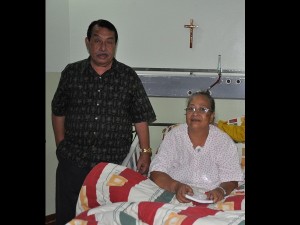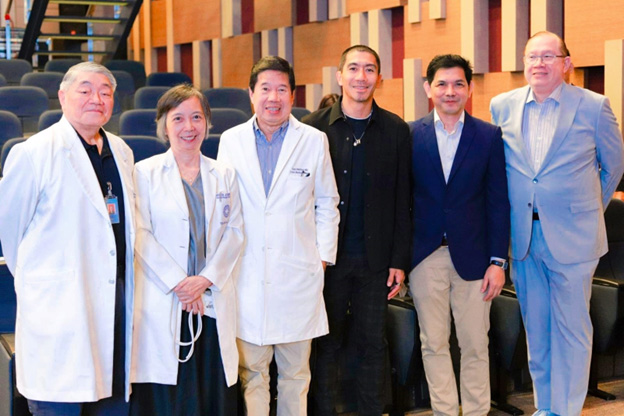
IT’S NOT EVERY DAY THAT A PHILIPPINE HOSPITAL TREATS ROYALTY, but that’s what happened when Iso Nanhken Iriarte and his wife Nahnken Hei, leaders of the kingdom of Pohnpei of the Federated States of Micronesia (FSM) went to the Philippine Heart Center. Iso’s wife needed to have some diagnostic procedures done on her heart and they chose to go to the Philippine Heart Center.
Nahnken Hei’s non-royal, birth name is Ruth Iriarte and she is a Vice-President of the Bank of FSM. She gladly shared her experience as a patient at the Philippine Heart Center. She said that it was okay for Filipinos to call her by her birth name—but in Pohnpei, calling her by that would be a disrespect to her status.
“We chose to go to the Philippine Heart Center because of its expertise. Also, during my stay here, I feel very much that the doctors and nurses here really care for me. I feel safe,” said Ruth.
She said that there was a suggestion for her to go to a medical facility in China. However, she preferred to go to the Philippines for several reasons.
“First of all, Chinese culture is very different from that of Pohnpei and the other islands in Micronesia. Our culture and that of the Philippines are very similar. Also, Filipinos speak English very well,” she said. Pohnpei, Ruth explained, is a territory under the administration of the United States and the currency there is the U.S. dollar. This means that she and her husband are able to change their dollars to pesos in the Philippines.
Her husband, Iso Nahnken, said that the exchange rate between the two currencies lowers the cost of their travel and medical care in the Philippines.
Ruth is very appreciative of how the doctors, nurses and other medical staff treated her. “They treat me very well. They are very friendly, very caring. I feel cured! I can feel their emotions, I see that they care. To me, having that kind of relationship is very important.”
Iso Nahnken echoed Ruth’s sentiment. “In FSM, there are Filipino doctors and they also check on us. They were the ones who recommended that we go to the Philippine Heart Center.”
The royal couple also found their hospital room comfortable enough for both of them to stay there instead of a hotel. “I find it very comfortable and safe. I like it better here than in a hotel,” said Ruth.
Iso added that he found staying at the hospital very convenient. “The accommodations are all right. The space is big enough for us to stay in. It’s easy to get whatever we need right here at the hospital,” he said.
The even shared a very interesting story about the Philippine Heart Center involving Iso’s brother. According to them, Iso’s brother went through cardiovascular surgery ten years ago at the Philippine Heart Center. The brother was extremely pleased at how his Filipino cardiologist and surgeon attended to them.
“My brother felt that his cardiologist and the rest of the medical staff at the Philippine Heart Center treated them like family. He felt that his doctor was not only treating them as patients—he said that he was practically a parent to him when he was here.
“The doctor operated on my brother on the same day that his son was born. And so, when the baby was born, they named the baby after the surgeon. That boy is now ten years old, and his name is Charleson, named after the doctor,” Iso revealed.
Filipinos first
According to Dr. Gerardo Manzo, the Philippine Heart Center’s Assistant Director for Medical Services, the Philippine Heart Center treats about 350 to 450 foreign patients a year—a small number compared to the 13,000 Filipino patients that the facility is able to treat on an annual basis. However, he said that the PHC would not mind being able to treat more foreign patients, since this still benefits their facility’s Filipino patients.
“That is where we try to balance things. Whatever subsidy the Heart Center gets from government, all of it automatically goes to the charity wards, to be spent on the patients there. The rest of whatever revenues the hospitals gets is spent on salaries, operations and maintenance costs. Now, whatever extra earnings the hospital receives–from medical tourism, for example–also goes to the Filipino patients in our charity wards. So in the end, our Filipino patients are still the ones that benefit.
“So, if we were to send a message to foreign patients, it would be that if they go for treatment at the Philippine Heart Center, they would be receiving quality, compassionate and patient-focused care from an internationally accredited, world-class cardiovascular facility—and at the same time, they would also be able to help Filipino patients of limited means to receive the same type of care. That’s a good thing—the ones that can afford medical care are able to help those with lesser means,” Dr. Manzo explained.
He added that the Philippine Heart Center does not charge separate rates for foreign patients and Filipino patients. Both groups are charged the same rates, and these rates are published in the hospital’s website at www.phc.gov.ph.
And yet, the Philippine Heart Center has not been actively marketing itself as a world-class cardiovascular facility, which is exactly what it is by now after it was awarded a Gold Certification from Accreditation Canada International in August 2011. The accreditation, according to Manzo, was not done for foreign patients—it was sought primarily to ensure the quality of the Philippine Heart Center’s service to Filipinos.
“Let me make it clear that the Philippine Heart Center is here primarily to provide medical care to Filipinos. All of the improvements we’ve made to bring to world-class levels the quality of our facilities, equipment, medical and surgical treatments, operations and services have been done–and will continue to be done–to benefit Filipino patients. Now, if foreign patients wish to come to us for treatment, then we will admit them because we are sure that we would be able to treat them here,” he said.
Recently, the Philippine Heart Center acquired the very first Lighting Room in its ICU; it is the very first in Asia and only the second in the world. The Lighting Room has its lights operated by software that follows the human circadian rhythm, which aids in treating patients by making sure their natural rhythms of rest and recovery are maintained.
The Philippine Heart Center will have, by mid-2012, the first and only Hybrid Operating Room in the Philippines and only the third Hybrid OR in Asia. A Hybrid OR is a highly-advanced and complex working environment for large teams of surgeons, nurses, anesthesiologists and technicians. The Hybrid OR allows all the members of the medical team to work efficiently and seamlessly together, which greatly increases the success of the surgery for the patient.
Dr. Manzo said that the Philippine Heart Center currently has 382 rooms and will soon be expanding to 450 rooms. “We want people to know that the Philippine Heart Center is always doing its utmost to continually upgrade its facilities and services, in order to serve our patients better. This is our lifelong commitment.” he said.









































